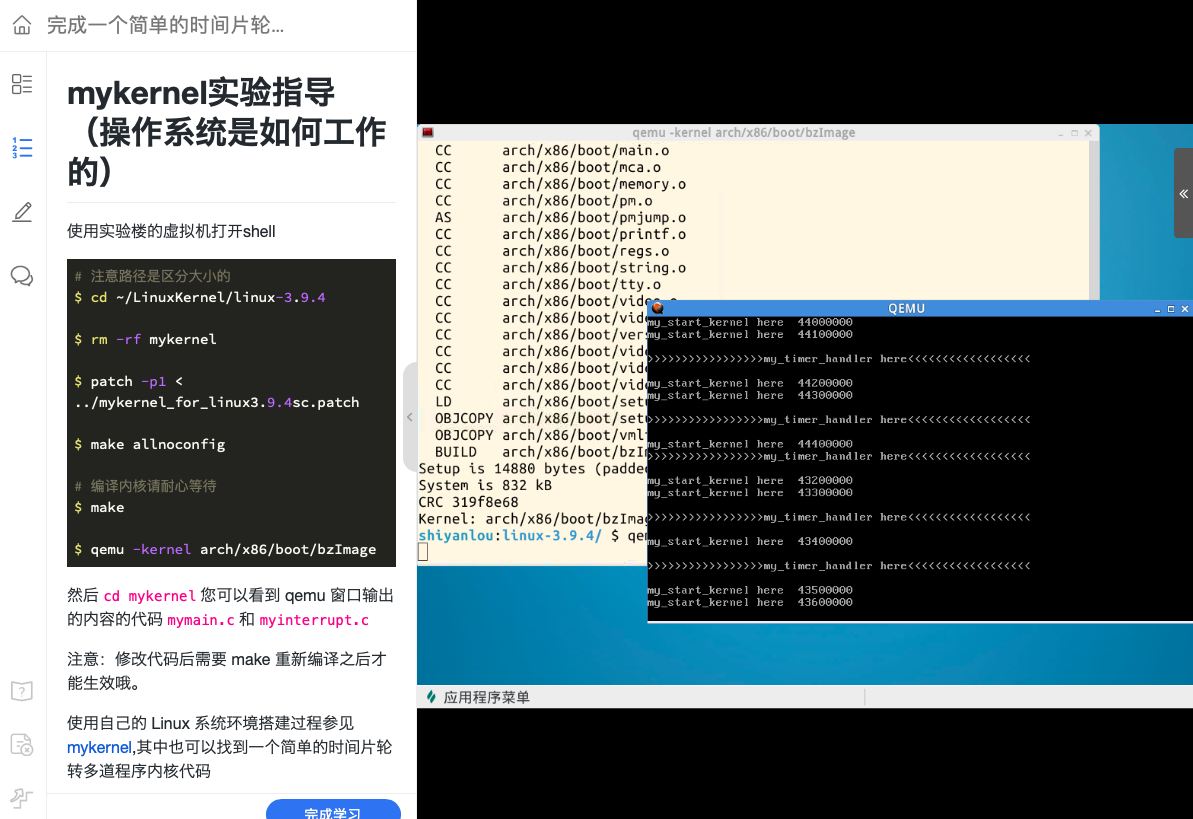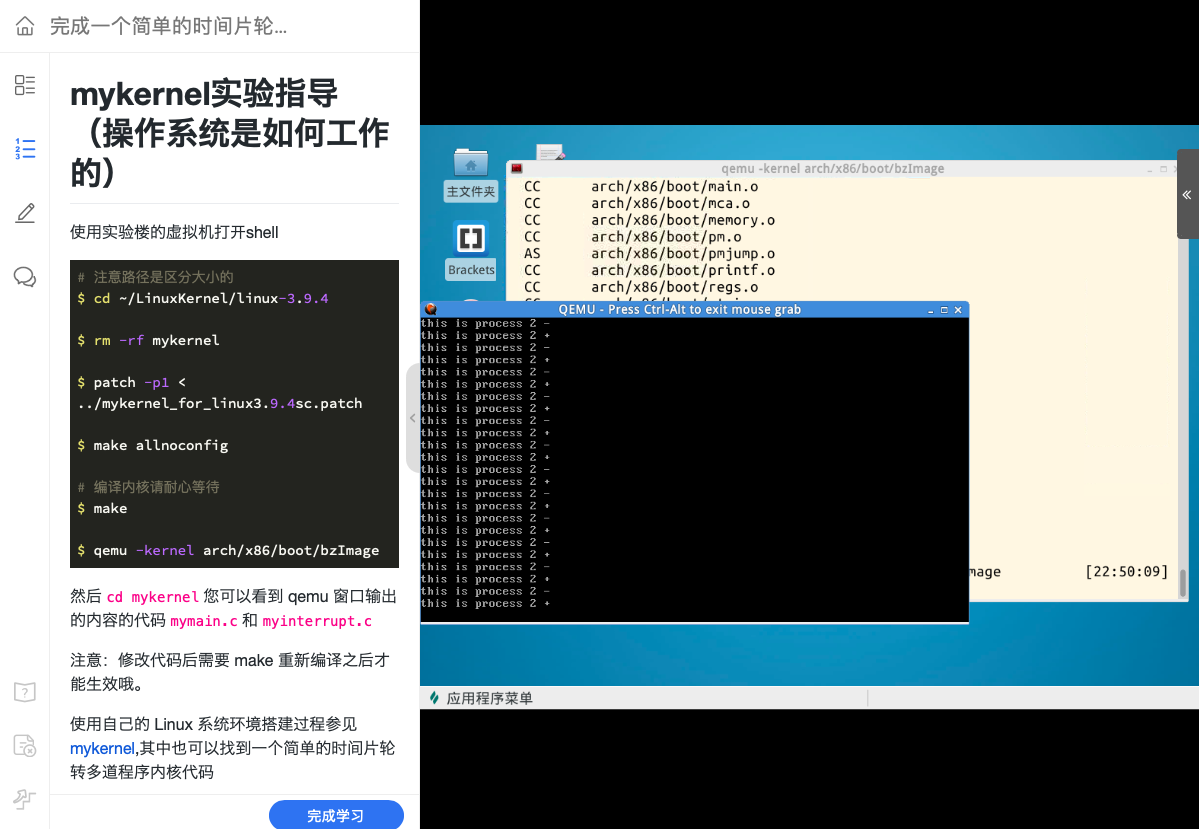2020-2021-1 20209307《Linux内核原理与分析》第三周作业
一、计算机的三大法宝
存储程序计算机、函数调用堆栈机制、中断机制
二、堆栈
堆栈的作用:记录函数调用框架、传递函数参数、保存返回值的地址、提供局部变量存储空间
堆栈操作:push栈顶地址减少四个字节、将操作数压入栈顶存储单元,pop栈顶地址增加四个字节、将栈顶存储的内容放回原寄存器。
堆栈相关寄存器:ESP堆栈指针、EBP基址指针、CS:EIP总是指向下一条指令地址
三、实验二
1、搭建虚拟的x86CPU实验平台

2、修改代码
mymain.c,这里是mykernel内核代码的入口,负责初始化内核的各个部分。
#include <linux/types.h> #include <linux/string.h> #include <linux/ctype.h> #include <linux/tty.h> #include <linux/vmalloc.h> #include "mypcb.h" tPCB task[MAX_TASK_NUM]; tPCB * my_current_task = NULL; volatile int my_need_sched = 0; void my_process(void); void __init my_start_kernel(void) { int pid = 0; int i; /* Initialize process 0*/ task[pid].pid = pid; task[pid].state = 0;/* -1 unrunnable, 0 runnable, >0 stopped */ task[pid].task_entry = task[pid].thread.ip = (unsigned long)my_process; task[pid].thread.sp = (unsigned long)&task[pid].stack[KERNEL_STACK_SIZE-1]; task[pid].next = &task[pid]; /*fork more process */ for(i=1;i<MAX_TASK_NUM;i++) { memcpy(&task[i],&task[0],sizeof(tPCB)); task[i].pid = i; task[i].thread.sp = (unsigned long)(&task[i].stack[KERNEL_STACK_SIZE-1]); task[i].next = task[i-1].next; task[i-1].next = &task[i]; } /* start process 0 by task[0] */ pid = 0; my_current_task = &task[pid]; asm volatile( "movl %1,%%esp\n\t" /* set task[pid].thread.sp to rsp */ "pushl %1\n\t" /* push rbp */ "pushl %0\n\t" /* push task[pid].thread.ip */ "ret\n\t" /* pop task[pid].thread.ip to rip */ : : "c" (task[pid].thread.ip),"d" (task[pid].thread.sp) /* input c or d mean %ecx/%edx*/ ); } int i = 0; void my_process(void) { while(1) { i++; if(i%10000000 == 0) { printk(KERN_NOTICE "this is process %d -\n",my_current_task->pid); if(my_need_sched == 1) { my_need_sched = 0; my_schedule(); } printk(KERN_NOTICE "this is process %d +\n",my_current_task->pid); } } }
myinterrupt.c,主要增加了my_schedule(void)函数
#include <linux/types.h> #include <linux/string.h> #include <linux/ctype.h> #include <linux/tty.h> #include <linux/vmalloc.h> #include "mypcb.h" extern tPCB task[MAX_TASK_NUM]; extern tPCB * my_current_task; extern volatile int my_need_sched; volatile int time_count = 0; void my_timer_handler(void) { if(time_count%1000 == 0 && my_need_sched != 1) { printk(KERN_NOTICE ">>>my_timer_handler here<<<\n"); my_need_sched = 1; } time_count ++ ; return; } void my_schedule(void) { tPCB * next; tPCB * prev; if(my_current_task == NULL || my_current_task->next == NULL) { return; } printk(KERN_NOTICE ">>>my_schedule<<<\n"); /* schedule */ next = my_current_task->next; prev = my_current_task; if(next->state == 0)/* -1 unrunnable, 0 runnable, >0 stopped */ { my_current_task = next; printk(KERN_NOTICE ">>>switch %d to %d<<<\n",prev->pid,next->pid); /* switch to next process */ asm volatile( "pushl %%ebp\n\t" /* save rbp of prev */ "movl %%esp,%0\n\t" /* save rsp of prev */ "movl %2,%%esp\n\t" /* restore rsp of next */ "movl $1f,%1\n\t" /* save rip of prev */ "pushl %3\n\t" "ret\n\t" /* restore rip of next */ "1:\t" /* next process start here */ "popl %%ebp\n\t" : "=m" (prev->thread.sp),"=m" (prev->thread.ip) : "m" (next->thread.sp),"m" (next->thread.ip) ); } return; }
运行结果如图:




 浙公网安备 33010602011771号
浙公网安备 33010602011771号